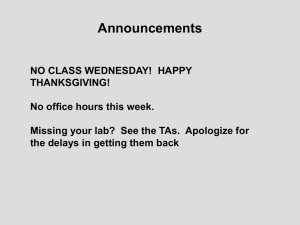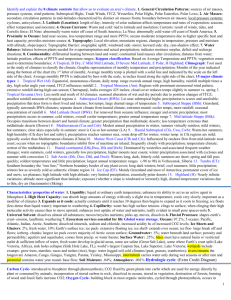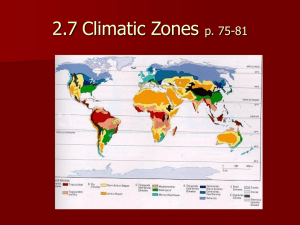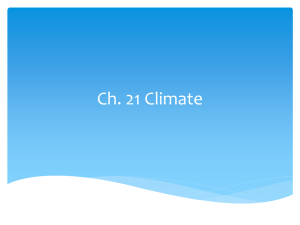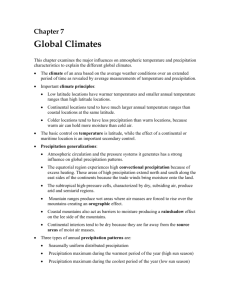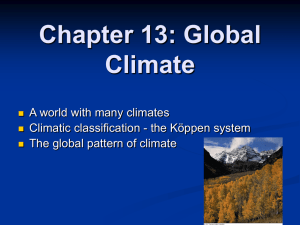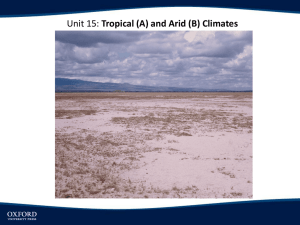Chapter 14 - Atmospheric Science Group
advertisement
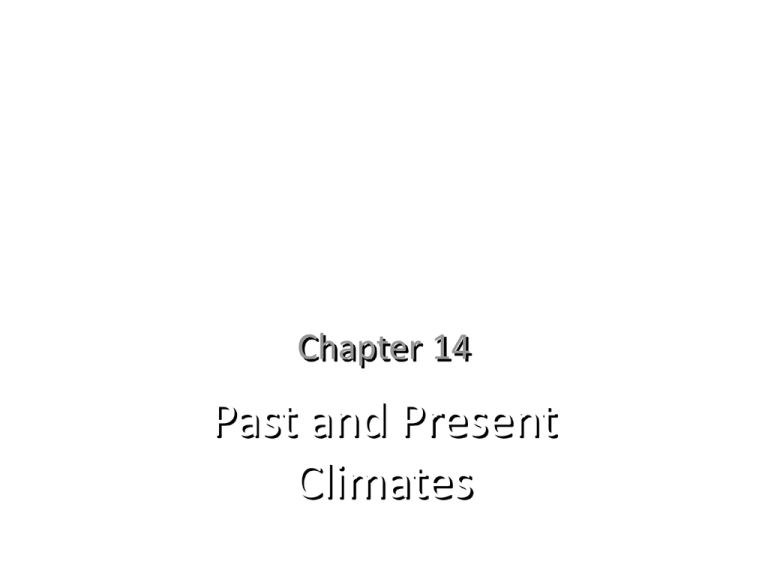
Chapter 14 Past and Present Climates Figure CO: Chapter 14, Past and Present Climates--Mendenhall Glacier in Alaska. Courtesy of Anatoly Myaskovsky Figure UN01: Susan Solomon Courtesy of Susan Solomon, NOAA Climate • Is to weather what a friend’s personality is to his/her mood • Sums up the weather’s long-term behavior • Is the collective state of the atmosphere for a given place over a specified interval of time Climate is defined by • Location – Globe, continent, region, city – Chapter 14: regional and global scale • Time: a specified interval – 30 year average is normal – 100 years or longer for history of climate • Averages and extremes of variables – Chapter 14: temperature and precipitation Controls on Climate • • • • Similar to controls on temperature in Chapter 3 Latitude: solar energy input Elevation: air temperature, snow vs. rain Topography: moist vs. dry, temperature, distribution of cloud patterns, solar energy reaching the surface Controls on Climate (continued) • Proximity to large bodies of water – Thermal properties of water (absorption, heat capacity, transparency, mixing) moderate temperature downwind • Prevailing atmospheric circulation – Intertropical Convergence Zone (ITCZ) – Subtropical Highs Classifying Climate • Hard to do – No clear boundaries – Complex natural systems • How it is done – Important to life: hot or cold; moist or dry – Most common system: based on vegetation • Köppen climate classification scheme based on vegetation and temperature Köppen (KEPP-in) Scheme • • • • Modified by Trewartha and Horn Related to geography and global circulation In Chapter 14, uses 1, 2 or 3 letters Has many other subdivisions within the categories shown in our textbook • Has 6 major groups: A, B, C, D, E, H The 6 major climate groups • • • • • • • • A: Tropical moist B: Dry (can be subtropical or mid latitude) C: Moist with mild winters (mid latitude) D: Moist with severe winters (mid latitude) E: Polar (high latitude) H: Highland (rapid climate change with elevation) 2nd letter: precipitation and dry periods 3rd letter: differences in temperature Figure 01: Overview of the main climatic groups Figure 02: Koppen Scheme Reproduced from: Peel MC, Finlayson BL & McMahon TA (2007), Updated world map of the Köppen-Geiger climate classification, Hydrology and Earth System Sciences, 11, 1633-1644. Figure 03: Classification and global circulations Tropical Humid Climates: Af, Aw, Am • All tropical (A) climates are humid • Letter “f” means no dry season, rain year round, usually closest to the equator • Letter “m” means “monsoonal”, with a short dry season and a very rainy season • Letter “w” means “winter dry season” except no real winter in tropics, just cool Tropical Humid Climates (continued) • Af – – – – – – Closest to the equator Smallest annual range of temperature 6.9-10 inches of rain per month Most thunderstorms in afternoon Linked to ITCZ Tropical rain forests • Am – Seasonal onshore winds during summer monsoon – Climates with most yearly precipitation – Jungle vegetation Tropical Moist Climates (continued) • Aw – – – – – – Farthest A climate from the equator Often border Af Tropical wet and dry Wet summers, dry, cooler winters Linked to the seasonal migration of the ITCZ Vegetation is savannah or tropical grasslands with scattered deciduous trees, as in the grasslands of Africa. Figure 04: Monthly temperature and precipitation: Af, Aw, Am Dry (B) Climates • Potential evaporation minus precipitation greater than zero • More land of this climate type than any other • Lubbock has a B climate • Descending branch of the Hadley circulation near the subtropical highs or • Rain shadow of a mountain range Dry Climate Subtypes • 2nd letter – “S” for steppe or semi-arid (like Denver) – “W” for true desert (extremely dry) • 3rd letter – “h” for low-latitude, hot (yearly average temperature >= 64ºF) – “k” for mid latitude, cool (yearly average temperature <64ºF) Dry Climate Subtypes (continued) • BWh Extremely dry and hot; can have large sand dunes; Sahara, Arabian peninsula, central Australia, most extreme B climate • BSk Least extreme B climate; mid latitude steppe, often high plateau, Lubbock, Denver, San Diego; often rain shadow • BSh Much of Mexico, lower latitude, subtropical steppe • BWk Central Asia, very dry, mid latitude rain shadow, continental interior Figure 05: Monthly temperature and precipitation: BSh,BWh Data from CIRA/Colorado State University and NOAA Figure 06: Monthly temperature and precipitation: BSk,BWk C Climate Type • All C are moist, plentiful precipitation • All C are midlatitudes • Average temperature of coolest month between 27ºF and 65ºF • Have many subtypes; Chapter 14 concentrates on a few • 2nd letter like A subtypes – “f” no dry season – “w” brief dry period in winter C Climate Type (continued) • 3rd letter – “a” hot summer – “b” warm summer – “c” cool summer C Climate Subtypes • Cfb, Cfc Marine west coast – Northwest coast of US, Canada – Often cool ocean currents • Cfa, Cwa Humid subtropical – Southeastern US – 30-100 inches of rain per year • Csa, Csb Mediterranean – Along a coast, mild winter – Greece – Dry summer, semi-permanent subtropical high Figure 07: Monthly temperature and precipitation: CfbCfc Figure 08: Monthly temperature and precipitation: Cfa,Cwa Figure 09: Monthly temperature and precipitation: Csa,Csb D Climate Type Severe (Winter) Midlatitude • • • • • Similar to C but severely cold winter Average temperature of coldest month <27ºF Snow on ground for extended periods Average temperature of warmest month >50ºF Overall, large change in temperature with season D Climate Subtypes • 2nd letter – “f” no dry season – “w” winter dry season • 3rd letter – – – – “a” hot summer “b” warm summer “c” cool summer “d” extremely severe winter Figure 10: Monthly temperature and precipitation: Dwb,Dfb Figure 11: Monthly temperature and precipitation: Dfc,Dfd D Climate Subtypes (continued) • Humid continental – Dfa, Dfb, Dwa, Dwb – Dfa, for example, Chicago • Subarctic – Dfc, Dfd, Dwc, Dwd – Long winter – Brief cool summer E Climate Type • Polar climate, very dry and cold • Poleward of Arctic/Antarctic Circle, latitude 66.5º • E climate subtypes – ET Tundra: mosses, lichens, flowering plants, woody shrubs, small trees, permafrost – EF Ice caps: no vegetation; Greenland, Antarctic Plateau Figure 12: Monthly temperature and precipitation: ET,EF H Climate Type: Highland • Large variation of temperature and precipitation over small horizontal distances • Large diurnal temperature variation • Can be dry or moist, depending on orientation, humidity, and whether prevailing winds are upslope or downslope Have today’s climates always been the same? • This question leads to the study of past climates. • So do the questions: Can we predict future climates? What is the impact of humans on climate? • Two kinds of past climate: – Historical, past few thousand years – Paleoclimate, ancient, back billions of years Figure 13: Climate clues Figure 14: Cave drawing of giraffe Courtesy of Roberto D’Angelo Another source of data for the historical period is trees • Tree rings are rings of growth in tree trunks in regions with distinct growing seasons. • A wider tree ring means more growth. • Growth varies with temperature and precipitation, depending on the species. • Information from various species is most helpful. • The study of tree rings is dendrochronology, and is done by dendrochronologists. • Figure shows dry periods in Iowa in 1700, 1740, 1820, 1820, 1890, and 1930 from tree rings. Figure 15: Tree rings Courtesy of Peter Brown, Rocky Mountain Tree-Ring Research Tree rings as a proxy for precipitation • Dry periods – – – – – Around 1700 1740 1820 1890 1930s, the “Dust Bowl” Figure 16: Tree ring history Duvick, D. N. and T. J. Blasing, 1981. A dendroclimatic reconstruction of annual precipitation amounts in Iowa since 1680. Water resources research, 17:11831189. Pollen as a proxy for temperature • • • • • • • Pollen degrade slowly Distinctive shapes for each species Oldest sediments are deepest Spruce need a cool climate Decline of spruce during warming Pine need a warm and moist climate Oak need it drier than pine Figure 17: Tree pollen Adapted from T. Graedel and P. Crutzen. Atmosphere, Climate, and Change. Scientific American Library, 1997. Spruce: © prism68/ShutterStock, Inc., Alder: © psamtik/ShutterStock, Inc., Birch: © kosam/ShutterStock, Inc., Pine: © Arkady/ShutterStock, Inc., Oak: © Nina Morozova/Dreamstime.com Dating Ancient Climates • Living things all contain carbon • C14 begins to change to C12 in a radioactive decay process at an exponential rate with a half-life of 5760 years as soon as living matter dies • Carbon dating good to 50,000 yrs with an uncertainty of about 15%. • For older samples and rocks need another method Dating really ancient climates • Uranium-238 decays into Lead-206 with a half-life of 4.5 billion years • No other (except possibly human) sources of Lead206 • How we know how old the Earth and moon are • If equal amounts of Uranium-238 and Lead-206, then 4.5 billion years old. Glaciers, Icebergs, Bubbles, and Dust • Climate clues buried in ice just as in lake sediments • When snow and ice exceed melting, glaciers form. Ice crystals crush under pressure, trapped air expelled, and bubbles form • Ice 30-m thick can flow downhill. At the coast, calving produces icebergs when the glacier breaks, with as much as 90% underwater • Gas bubbles with CO2 and CH4 Figure B02: Iceberg satellite image Courtesy of SSEC/AMRC, University of Wisconsin-Madison Figure 18: 650,000 years in the past Adapted from Brook, Edward J, Science 310 (2005): 1285-1286 Figure 19: Kilimanjaro ice fields Thompson, L.G., H.H. Brecher, E. Mosley-Thompson, D.R. Hardy, and B.G. Mark. 2009. Glacier loss on Kilimanjaro continues unabated. Proceedings of the National Academy of Sciences Dust • Dust in ice cores can be volcanic activity, or dry and windy conditions • Acidic dust with sulfuric acid indicates volcanic activity • Dust storms in Africa can be detected in polar ice cores Marine Sediments • Current warmth is unusual • Ratio of Oxygen-18 to Oxygen-16 in shells of marine animals tells about amount of continental ice that was present when they lived • This method works back to 2-3 million years • Warm periods about every 100,000 years Figure 20: Oxygen ratio and temperature Adapted from Imbrie, J. and J. Z. Imbrie, Science 202 (1980): 943-953 Fossil records are oldest • Use Uranium dating for the oldest • Types of plants and animals give climate clues • Some plants live under very narrow conditions of temperature and humidity Figure T01_1: Earth’s Geological Periods Adapted from Bradley, R., Quaternary Paleoclimatology, Allen and Unwin, 1985. What Mechanisms Have Caused Climate Change in the Past • • • • • Overview: most sudden to the slowest Volcanic eruptions: acidity, overall cooling Asteroid impacts: overall cooling Solar variability: cooling or warming Variations in Earth’s orbit: Milankovitch cycles; cooling or warming • Plate tectonics • Changes in ocean circulation: can be rapid and longlasting • Natural variability: variations without forcing Asteroid Impacts • There may be a 26-million year periodicity in asteroid impacts • The demise of the dinosaurs coincided with an asteroid impact Figure 22_1: Chicxulub impact Courtesy of Virgil L. Sharpton, Lunar Planetary Institute Figure 22_2: Chicxulub impact Figure 23: Extinctions Adapted from T. Graedel and P. Crutzen. Atmosphere, Climate, and Change. Scientific American Library, 1997. Historical Climate • Humans have kept records • Instrumental record – Since about 1600 • Historical data: proxy data – Humans have kept some sort of record of climate conditions – Examples: dates of freezes of lakes and rivers, farmers’ logs, animals in cave paintings, other documents Sunspots and Climate • The Maunder minimum in sunspot count occurred between 1650 and 1700 • The Little Ice Age in Europe occurred between about 1400 and 1850 Figure 24: Sunspots Source: NASA Milankovitch Cycles • • • • Precession, which star is the north star, 27,000 years Obliquity, tilt varies from 22 to 24.5°, 41,000 years Eccentricity, orbit more/less elliptical, 100,000 years Cold periods 20,000, 60,000, and 100,000 years ago Figure 25A: Earth’s Orbital variations Figure 25B: Earth’s Orbital variations Adapted from T. Graedel and P. Crutzen. Atmosphere, Climate, and Change. Scientific American Library, 1997. Plate Tectonics and Continental Drift • Pangaea, one large tropical supercontinent, 300 million years ago • 160-230 million years ago, a split occurred • Laurasia: Asia, Europe, North America • Gondwanaland: South America, Africa, India, Australia, Antarctica • Collisions caused Himalayas, Rocky Mtns. • Maybe ice sheets when continents became less tropical Figure 26A: Plate tectonics Figure 26B: Plate tectonics Figure 26C: Plate tectonics Ocean Circulation • The thermohaline circulation is a world-wide 3dimensional ocean circulation • Sinking motion occurs in the North Atlantic when ice melts • This circulation can be cut off when melt causes water to be less dense and not sink • The cutoff may be responsible for cooling in a period of glacial melt Figure 27: The extent of the ice sheets over North America during the Pleistocene Figure 28: The temperature (orange) and ice accumulation (blue) in central Greenland Source: NOAA

